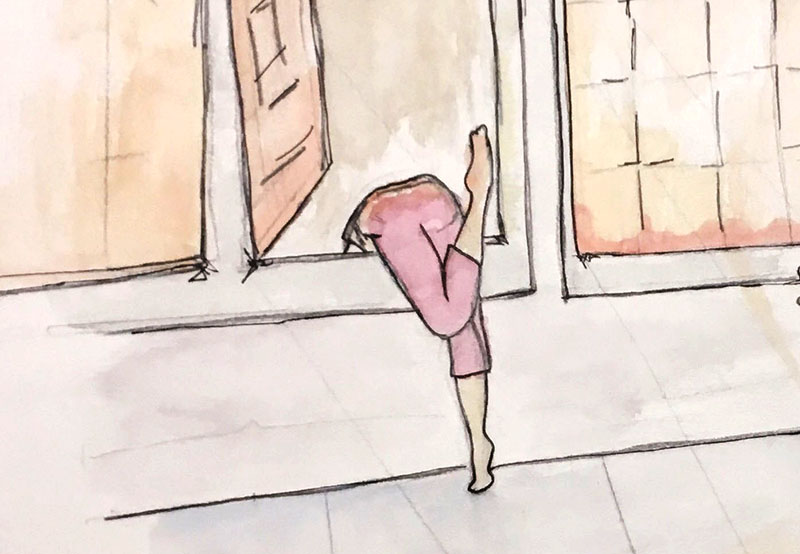Wrapping Up 2020 with A Look at The Field
BY EMMALY WIEDERHOLT; ILLUSTRATION BY CAMILLE TAFT
Welcome to the end of 2020. Take a bow. You have made it through an incredibly difficult year. Our sense of normal has been thrown out the window, and with it, what little security existed in the dance field. The performing arts in general have been especially hard hit. For dance artists, it’s become almost impossible to do what we do.
The view from the window (the one normal was thrown out of) looks both bleak and hopeful from where I sit. As I write this, coronavirus case numbers are skyrocketing as we head into what looks like a difficult and isolating winter. But there are a handful of vaccines developed that will eventually be distributed and Trump is headed out of office. I am worried about what’s to come in the next few months with hospitals full and a fraught transition of presidential power, but I am optimistic that in the long run the events of 2020 will bring about needed change.
I wanted to know what the dance field will look like post new normal, so I reached out to the leaders of major dance organizations across the country to find out how they have navigated this past year and what they foresee will be the impact of 2020. I interviewed the directors of Dance/USA, Dancers’ Group in the Bay Area, Dance Resource Center in Los Angeles, Boston Dance Alliance, and DanceATL in Atlanta, as well as of Jacob’s Pillow (a major dance festival in Becket, Massachusetts) and NCCAkron (a choreographic center in Akron, Ohio). This is clearly not a list of all the major dance organizations; it’s just a sampling of who I managed to get in touch with as 2020 draws to a close.
Their responses, as you’ll see in the coming weeks as I publish their interviews, underlie just how cataclysmic 2020 has been to the dance field. From the lockdowns and social distancing measures meant to stymie viral spread, to the protests and heightened awareness of racial injustice following the murder of George Floyd, to the daily task of adapting to video technology in the quest to continue making classes and performances available, it quickly becomes apparent there is no going back to the way things were in 2019.
Some of the changes wrought make me excited. The most obvious and long overdue is addressing racism and white supremacy embedded within our institutions. I took heart that none of the leaders I spoke with had only started addressing marginalization within their respective institutions this year; most had begun the process years prior of taking a deep look at how their organizations were serving and representing people of color. The events of this year have sped up that effort. This is not to say there aren’t dance organizations in desperate need of introspection, but the ones I spoke with have been actively moving toward thorough reevaluation of their institutions.
Another change I’m looking forward to is the awareness that the health of dance artists, both mental and physical, is not disposable. As more of the public has dealt with anxiety and depression, there’s been a call within our field to assess what has long been giving dance artists anxiety and depression: feeling overworked and undervalued. More than one dance organization I spoke with described regular affinity group meetings to provide support, and many had substantially lowered their membership dues. Others had raised and distributed COVID relief grants for artists. I hope such support measures become more common.
Finally, online access to classes and performances has been a way to engage students and audiences beyond studios and theaters. While we can agree it’s no permanent substitute to being in-person, all the dance organizations I spoke with described reaching new folks interested in their programming, often geographically far from where their dance organization is located. While consistent internet access is unfortunately not a privilege all have, and Zoom has become odious for many, it is a boon for people with disabilities, people living outside major metropolitan areas, or people just unable to get across town through traffic. All the leaders I spoke with describe a hybrid model going forward of online and in-person content.
I hope you enjoy reading my interviews with these dance leaders over the coming weeks and take heart that while this year has caused massive devastation, the vibrancy of the dance field is not diminished in any way, and has even started to rectify some glaring inadequacies. When 2020 came and our sense of normal was thrown out the window, perhaps we got some much needed fresh air.
~~

